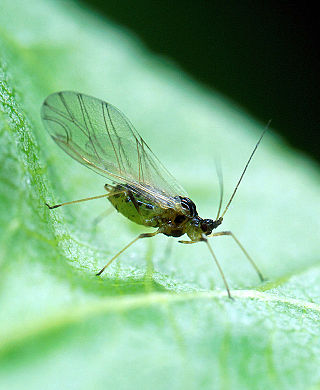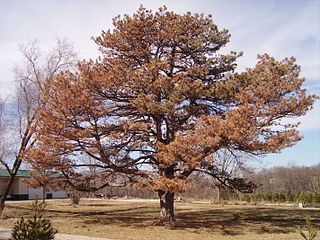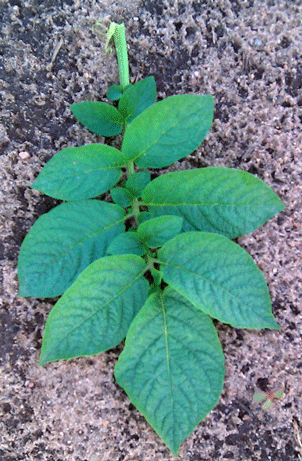
The potato is a starchy root vegetable native to the Americas that is consumed as a staple food in many parts of the world. Potatoes are tubers of the plant Solanum tuberosum, a perennial in the nightshade family Solanaceae.

The Colorado potato beetle, also known as the Colorado beetle, the ten-striped spearman, the ten-lined potato beetle, or the potato bug, is a major pest of potato crops. It is about 10 mm long, with a bright yellow/orange body and five bold brown stripes along the length of each of its elytra. Native to the Rocky Mountains, it spread rapidly in potato crops across America and then Europe from 1859 onwards.

Fusarium wilt is a common vascular wilt fungal disease, exhibiting symptoms similar to Verticillium wilt. This disease has been investigated extensively since the early years of this century. The pathogen that causes Fusarium wilt is Fusarium oxysporum. The species is further divided into formae speciales based on host plant.

Potato leafroll virus (PLRV) is a member of the genus Polerovirus and family Solemoviridae. The phloem limited positive sense RNA virus infects potatoes and other members of the family Solanaceae. PLRV was first described by Quanjer et al. in 1916. PLRV is transmitted by aphids, primarily the green peach aphid, Myzus persicae. PLRV is one of the most important potato viruses worldwide but particularly devastating in countries with limited resources and management. It can be responsible for individual plant yield losses of over 50%. One estimate suggests that PLRV is responsible for an annual global yield loss of 20 million tons. Symptoms include chlorosis, necrosis and leaf curling.

Verticillium wilt is a wilt disease affecting over 350 species of eudicot plants. It is caused by six species of Verticillium fungi: V. dahliae, V. albo-atrum, V. longisporum, V. nubilum, V. theobromae and V. tricorpus. Many economically important plants are susceptible including cotton, tomatoes, potatoes, oilseed rape, eggplants, peppers and ornamentals, as well as others in natural vegetation communities. Many eudicot species and cultivars are resistant to the disease and all monocots, gymnosperms and ferns are immune.

The tomato is the edible berry of the plant Solanum lycopersicum, commonly known as the tomato plant. The species originated in western South America, Mexico, and Central America. The Nahuatl word tomatl gave rise to the Spanish word tomate, from which the English word tomato derived. Its domestication and use as a cultivated food may have originated with the indigenous peoples of Mexico. The Aztecs used tomatoes in their cooking at the time of the Spanish conquest of the Aztec Empire, and after the Spanish encountered the tomato for the first time after their contact with the Aztecs, they brought the plant to Europe, in a widespread transfer of plants known as the Columbian exchange. From there, the tomato was introduced to other parts of the European-colonized world during the 16th century.

A crop wild relative (CWR) is a wild plant closely related to a domesticated plant. It may be a wild ancestor of the domesticated (cultivated) plant or another closely related taxon.

Myzus persicae, known as the green peach aphid, greenfly, or the peach-potato aphid, is a small green aphid belonging to the order Hemiptera. It is the most significant aphid pest of peach trees, causing decreased growth, shrivelling of the leaves and the death of various tissues. It also acts as a vector for the transport of plant viruses such as cucumber mosaic virus (CMV), potato virus Y (PVY) and tobacco etch virus (TEV). Potato virus Y and potato leafroll virus can be passed to members of the nightshade/potato family (Solanaceae), and various mosaic viruses to many other food crops.

Plant disease resistance protects plants from pathogens in two ways: by pre-formed structures and chemicals, and by infection-induced responses of the immune system. Relative to a susceptible plant, disease resistance is the reduction of pathogen growth on or in the plant, while the term disease tolerance describes plants that exhibit little disease damage despite substantial pathogen levels. Disease outcome is determined by the three-way interaction of the pathogen, the plant and the environmental conditions.

A wilt disease is any number of diseases that affect the vascular system of plants. Attacks by fungi, bacteria, and nematodes can cause rapid killing of plants, large tree branches or even entire trees.
Solanum tuberosum Group Phureja is a cultivar-group of diploid potato plants originating from the Andes valley in South America. The group differs from other potato cultivar-groups by the absence of dormant tubers. This means that the tuber immediately begins to grow once it is formed, without a resting period. This explains why the varieties of the group are to be planted in areas with a mild climate, where culture throughout the year is possible. By hybridization with Solanum tuberosum by the Scottish Crop Research Institute, varieties were obtained who are adapted to the European climate. These crossings are particularly popular as a culinary potato for their excellent taste.

The Atlantic potato is a mid-season potato variety for potato chip manufacturing. It was developed and released by USDA Agricultural Research Service scientists at Beltsville, Maryland, in 1978. The variety is not under plant variety protection. It is a progeny of a cross between 'Wauseon' and 'Lenape'. It is widely grown for chipping directly off the field or with short-term storage. Marketable yields are fairly high.

Bintje is a middle-early ripening potato variety bred in the Netherlands by the Frisian schoolmaster K.L. de Vries in 1904 from and marketed for the first time in 1910. The name of the potato, a diminutive of Benedict, was borrowed from one of his former students.
The Ranger Russet is a late-maturing potato that is used for baking and processing into fries. It was originally bred by Joseph J. Pavek of the USDA in Aberdeen, Idaho, and released jointly by the USDA and the agricultural stations of Idaho, Washington, Oregon and Colorado in 1991. Ranger Russet is not under plant variety protection. It yields medium to high numbers of tubers with a short dormancy period.

Gratiana boliviana is a species of beetle in the leaf beetle family, Chrysomelidae. Its common name is tropical soda apple leaf beetle. It is native to South America, where its distribution includes Argentina, Brazil, and Paraguay. It specializes on tropical soda apple, an invasive plant species. It has been released as an agent of biological pest control against the weedy plant in Florida and other parts of the United States.
Lenape (B5141-6) is a potato cultivar first released in 1967 and named after the Lenape Native American tribe, which had to be pulled from the market in 1970 after findings of its high glycoalkaloid content. It was bred by Wilford Mills of Pennsylvania State University in collaboration with the Wise Potato Chip Company. The Lenape potato was produced by crossing Delta Gold with a wild Peruvian potato known for its resistance to insects. It was selected for its high specific gravity and low sugar content which made it ideal for producing potato chips but it was also immune to potato virus A and resistant to common strains of late blight. It is of medium-late maturity and produces round, white tubers with shallow eyes.

Māori potatoes or taewa are varieties of potato cultivated by Māori people, especially those grown before New Zealand was colonised by the British.

Solanum commersonii is a species of wild potato in the family Solanaceae. It is native to southern Brazil, Uruguay, and northeastern Argentina, and has been introduced to Mauritius. It is a crop wild relative useful in potato breeding for its resistance to root knot nematode, soft rot, blackleg, bacterial wilt, verticillium wilt, Potato virus X, tobacco etch virus, common scab, and late blight, and for its frost tolerance and ability to cold acclimate.

Viral diseases of potato are a group of diseases caused by different types of Viruses that affect potato crops worldwide and, although they do not affect human or animal health since they are viruses that only infect vegetables, they are a source of great economic losses annually. About 28 viruses have been reported infecting potato crops. However, potato virus X (PVX), potato virus Y (PVY), and potato leafroll virus (PLRV) are the most important viruses worldwide. Some others are of economic importance only in some regions. Such is the case of potato virus M (PVM) in some Asian and European countries.
Solynta is a Dutch biotechnology company that specializes in hybrid potato breeding. It is headquartered in Wageningen, Gelderland, the Netherlands.
















